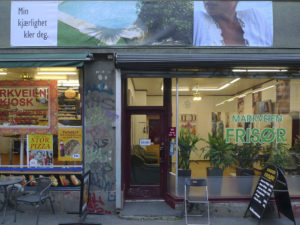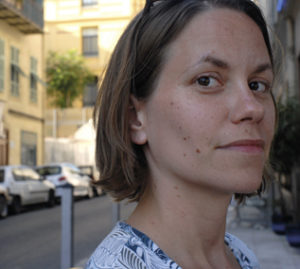 The exhibition “I can’t just be nowhere” by the German artist Thyra Schmidt had been shown for six weeks (09/18 – 11/01/2009) in the public space of Oslo, Norway. The large scale photos and text works on the house fronts of the city districts Oslo sentrum, Grøland and Grünerlokka had a very private character. Due to the presentation at the squares and streets of the city arise a tension in between intimacy and public display. These are unfamiliar sounds in our hyper mediatised world. Thyra Schmidt explains the backgrounds of the project in this interview. (November 2009)
The exhibition “I can’t just be nowhere” by the German artist Thyra Schmidt had been shown for six weeks (09/18 – 11/01/2009) in the public space of Oslo, Norway. The large scale photos and text works on the house fronts of the city districts Oslo sentrum, Grøland and Grünerlokka had a very private character. Due to the presentation at the squares and streets of the city arise a tension in between intimacy and public display. These are unfamiliar sounds in our hyper mediatised world. Thyra Schmidt explains the backgrounds of the project in this interview. (November 2009)
Astrid Gallinat: Until early November you have been with your project “I can’t just be nowhere” in Oslo. After a stopover in Düsseldorf you went straight to Milan for another project with FEHLSTELLE. You seem constantly to be somewhere. Is the title of your work in Oslo a personal statement? How did you get to this title?
Thyra Schmidt: I have taken the title from “Melancholia” by the Norwegian author Jon Fosse, the original sentence was: “… somewhere I have to be and I can’t just be nowhere …”
The works in my Oslo-project treat private topics, consciously cryptic placed in the public space. Thus for me the title “I can’t just be nowhere“ relates to something intimate, which seeks its place without losing its dignity.
If I refer the title to my travels, the more likely would be “I can be everywhere”…
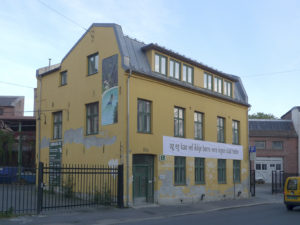
The yellow house in Lakkegata (Station No 4) “og eg kan vel ikkje berre vere ingen stad heller” – a quote from Melancholie by Jon fosse And in the same time the title of the project: “I can’t just be nowhere”
Astrid Gallinat: The texts are quotations from writers, sometimes slightly modified by you. Which are these writers and why did you cite them?
Thyra Schmidt: Well, I have to explain this more in detail: With the combination of text and image I have been working since 2003; I started with “striking” image compositions, illusionist photo- montages consisting of portraits, landscapes and already privately seeming image-immanent text phrases. Out of it several groups of works developed for me, in which I work in parallel to today and which I always put in other contexts.
Basically, it is the ingredients of my montages, except that I intensify them in each series. So to speak inevitably, a series of text fragments was grown, on which I work since 2007. In opposite of the text phrases of my montages, the texts have to work now as independent images for me, both content and formal. This content requires a degree of narrativity, although I do not intend to tell a story.
I am interested in statements that include interpersonal events, many texts are about happiness and love and eroticism. But there are also references to landscape or simple descriptions of a “human madness”– the latter I found particularly in the works of Knut Hamsun, Jon Fosse and Christoph Hein. But that I revert to different literature in this work, I really only see as a tool. Myself write the majority of the texts I use, sometimes there are statements that has been made to me. If I cite from literature, I usually do it in a very modified form; but even the mere removal from their original context has already led to a different meaning.
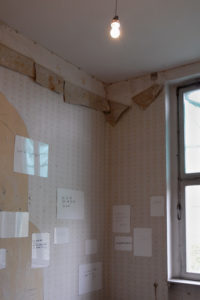
Congress of the Futurologists, 2007 Aktivist, Eisenhüttenstadt, Germany Thyra Schmidt: without title (textfragments), 2007
It has since developed as a collection of texts, continuously expanding and from which I ever use texts depending on a project or exhibition. That the selected texts for the Oslo-project are mostly based on quotes is more of a chance.
But to return again to your question: The literature I make use for reaches from Hölderlin to the romantics, to Baudelaire and others up to current writers.
Astrid Gallinat: In 2007 in Eisenhüttenstadt (and 2008 in Dunaujvaros, Hungary) you have already exhibited fragments of texts but this was in a completely different shape (interior, manuscripts, smaller format). Some of the texts were again represented in Oslo. Do the texts change for you if they are in a different context?
Thyra Schmidt: In each of both exhibitions around 40 or 50 of these texts hung close to each other, there was a tight net of relations between the lines.
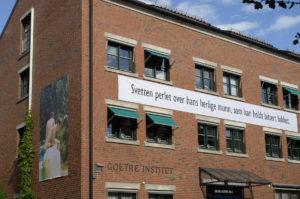
Goethe-Institute, Grønland 16 (Station No 1) “The perspiration pearled over his wonderful mouth, which he held tightly shut.” Bettine von Arnim about Goethe
In Oslo, however, each text was in conjunction with the city outside, where it was placed or additionally in conjunction with an image. The statement here is for me completely different.
Astrid Gallinat: As you write in the blog the photographs and texts are to consider independently from each other. Each work is an image for itself. Nevertheless sometimes they seem to fit together. For example at the Goethe-Institute: Grønland 16 (Station No. 1) “The perspiration pearled over his wonderful mouth, which he held tightly shut.” The photo besides shows two men while bathing in the pool, the heat and with it the sweat is almost tangible. However, here the pictures and the text are not next to each other.
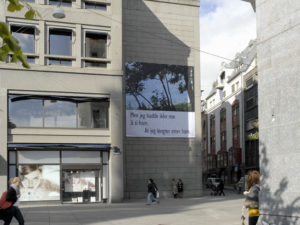
GlasMagasinet, Stortorvet 9/Torggata (Station No 2) “But I had nothing to tell him. That I longed for him.” Text fragment after Christoph Hein
At the same time some texts seem to be like stumbling blocks. For example “But I had nothing to tell him. That I longed for him.” at GlasMagasinet, Stortorvet 9/Torggata (Station No. 2). Did you consciously intend to create disharmony?
Thyra Schmidt: Within the course there were locations where I have placed only one text, and places where texts and images were shown together, sometimes separately, mounted across a corner on two sides of a house and sometimes directly next to or above each other in one placard work. In the composition of text and image, it was important to me, that the texts do not describe the pictures and at the same time do not too far remove from the image subject. If I had shown the works at the Goethe-Institut on one wall, I would have chosen a different text.
The text in the work on GlasMagasinet I personally do not feel as disharmonious. It was written under a landscape picture that could stress the message or could also describe the location of the author.
GlasMagasinet is a big department store in the middle of the city centre, it was most importantly for me that my work there differs more clearly from an advertising than in other places, the large showcase of the store were located nearby.
Astrid Gallinat: Even though there are no discords for you your work is somehow in contrast to our viewing habits, as we usually see smooth advertising in public buildings.
In this sense Markveien 58 (Station No. 5) “My love fits you!” is mounted above a hairdressing salon. Are your works best understood as “anti-advertising”?
Thyra Schmidt: No, as ”anti-advertising” I do not understand them, then I would have to advertise against a product. In this case, it was just humour.
Astrid Gallinat: “I can’t just be nowhere“ seems to me as an oversized poetry book or even as a diary that is flipped open on the streets of Oslo. Can you do something with this comparison or do you understand the project completely different?
Thyra Schmidt: I find this comparison very nice. It sounds so sentimental that you may feel it even as embarrassing … and that’s what I like.
But although I associate with “diary“ something autobiographic, what I put in my work more in question.
Astrid Gallinat: Although the works seem to be very intimate they stand in stark contrast to the baring of soul which is often offered in talk shows. Isn’t this silence also a contrast to the usual “noise” in the public space which in the end has the effect of an eye catcher?
Thyra Schmidt: As already described in my first answer, I try to treat intimate subjects with a certain dignity. This may be the reason why the works might be too mysterious or veiled for some viewers. In any case, it is something different than the way as in our society in the public media is handled with so-called privacy. As an artist I am interested in some phenomena in my time, but I do not intend to illustrate this. Ultimately, for me art is a language of form, even if I’m approaching this form of substantive issues.
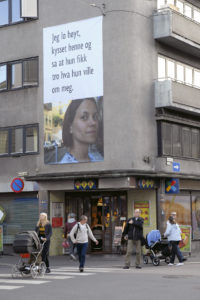
Markveien 48/ Nordre gate (Station No 6) “I laughed out loud, kissed her and said, she should think about me, what she wants.“ Changed quote after Christoph Hein
Astrid Gallinat: To what extent do you have selected the “pictures” especially for the audience in Oslo, or would they work similarly in another city such as Milan, as you were just there?
Thyra Schmidt: These images could also work in another town, but not in every country, in which case I would certainly choose other images.
Originally I wanted to show more pictures of landscapes in Oslo, which I soon abandoned in view of the impressive nature of Norway. The text- images would change in another language too.
Astrid Gallinat: Could you in generally imagine doing a comparable project in a similar shape again in another city?
Thyra Schmidt: A similar project in another city, I can well imagine, but it should not necessarily be a project with pictures and text placards on house walls; but it would still be a work that would deal in a certain form with intimacy in the public media. Here for conceivable for me is a game with various identities, which now only takes place in an approach in my work, in the form of the handwritten texts.
Ultimately, the question is asked, when and how a temporary project in public space is localized in the context of art. While it takes place, it is always also confronted with a crowd of people not interested in art; it’s a completely different situation than a museum visit.
Basically, in retrospect something is being discussed which do not exists any more, but which past form of exhibition still remains the basic of the work.
* This interview was held originally in German and has some more questions and answers. In the archive of ARTIFICIALIS you can read the original. The translations were made by Astrid Gallinat and Thyra Schmidt for the projects blog of the Goethe-Institute Oslo which is not longer available.
Photos:
© Thyra Schmidt
© 2009 ARTIFICIALIS

